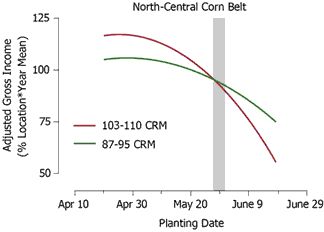Summary
- When rainfall significantly delays field and planting operations, switching to early maturity hybrids is sometimes needed to ensure timely crop maturation.
- To help guide these decisions, Pioneer researchers conducted planting date studies over 18 years (1987-2004). Studies included a range of hybrid maturities across planting dates extending from April through June.
- Results indicate that growers should plant full season hybrids in all regions of the Corn Belt until approximately May 27. Switching to an early maturity hybrid prior to this point most likely will not be beneficial and may result in reduced profitability.
- In the central Corn Belt, growers may choose to replace full season hybrids with early hybrids in late May, but there was no significant profit penalty for staying with a full or mid-maturity hybrid, even with delayed planting.
- In the north-central, northern, and far-northern Corn Belt, planting must be delayed until the last week of May or the first week of June before there is a high likelihood that switching to an early maturity hybrid will be profitable.
- Growers should consult their local Pioneer representative for recommendations about hybrid switches under delayed planting conditions.
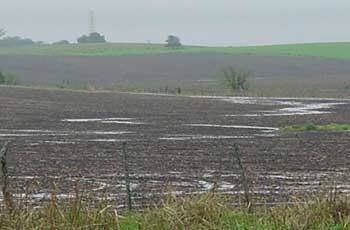
Delayed planting due to wet spring weather can cause growers to consider switching to an earlier maturity hybrid.
Introduction
When wet weather delays field work and planting, corn growers deliberate on whether to switch to earlier maturing hybrids. This is a critical decision that impacts producers' risk and profitability, especially in northern areas where growing season length often limits yield. Planting full-season hybrids too late puts them at risk of cool weather and fall frost damage before maturity, but switching to early hybrids too soon can result in severe yield and profit penalties.
Long-term studies by both Pioneer and universities have shown a clear yield and profit advantage for full-season hybrids. When planted in a timely fashion, these hybrids can make use of the entire growing season to reach their full yield potential. Even when planted late, these hybrids often outperform early maturing hybrids by adjusting their growth and development to reach maturity in a shortened growing season.
These critical hybrid switching decisions should be based on long-term research covering a wide range of climatic conditions. This Crop Insights reports results of Pioneer's planting date research to determine proper hybrid maturity switches under delayed planting situations.
Pioneer Long-Term Corn Planting Date Studies
Pioneer Agronomy Sciences has conducted planting date studies for over 30 years. This article reports results from 18 seasons across central, north central, north, and far north locations of the Corn Belt (Figure 1). Planting dates ranged from early April to mid-June. Several hybrids were included in each maturity group so that true maturity responses could be measured, rather than just specific hybrid responses.
- Full-season - Planted on the optimum planting date, these hybrids make full use of the available growing season*.
- Mid-maturity - Planted on the optimum planting date, these hybrids reach maturity before the end of the growing season*.
- Early maturity - These hybrids are used only under late-plant or replant situations by most growers.
*Assumes normal growing degree unit accumulation

Figure 1. Central (red), north-central (orange), northern (green), and far-northern (blue) research sites for Pioneer planting date studies from 1987-2004.
The experimental design was a randomized complete block in a split-plot arrangement with planting date as whole plot and hybrid as sub-plot with four replications. The plots were four rows wide and harvest data were collected from the center two rows of the plot. To allow for continued hybrid maturity development and grain drying, the later planting dates were harvested separately at many locations.
Adjusted gross income/acre was calculated as gross income at a corn price of $5.00/bu minus drying costs and discounts for low test weights. Drying costs were calculated based on 4 cents/bu for each point of moisture above 15%. The test weight discount schedule used for this analysis is shown in Table 2; however, discount rates vary among corn buyers. (Test weight discounts are more relevant to grain delivered wet to a buyer versus corn dried on the farm, as test weight increases significantly as moisture is removed by field or artificial drying.)
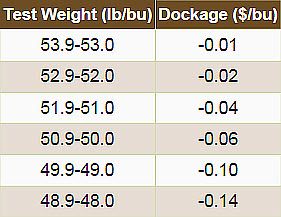
Hybrid Maturity Switching
Adjusted gross income was used to determine planting windows during which growers should consider switching from full season to early maturity hybrids, or from mid-maturity to early season hybrids. These windows are shown as shaded areas in Figures 2 through 9. Switching to an early maturity hybrid before the switching window will likely not be beneficial, and may even reduce profitability. Staying with a full season or mid-maturity hybrid after the switching window will likely result in reduced profitability. In some cases the switching window extends to the end of the planting date range used in these studies. This is because the data indicated no significant advantage to switching during the period.
Central Corn Belt
The central Corn Belt studies included 30 environments in Nebraska, Iowa, Illinois, and Indiana. Results of long-term Pioneer data show that April planting of full season hybrids provided the greatest profitability in this region (Figure 2).
Full season hybrids provided the greatest profitability when planted up until May 27.

Figure 2. Adjusted gross income response to planting date for 111-115 CRM (full season) and 99-102 CRM (early maturity) hybrids in 30 central Corn Belt environments during 1987-2004.
Growers may consider switching to an early maturity hybrid after this point; however, the economic advantage to doing so was not statistically significant in the studies.
Growers in the central Corn Belt planting mid-maturity hybrids should not consider switching to an early maturity hybrid unless planting is delayed until after June 9 (Figure 3). Growers may consider switching to an early maturity hybrid after this point; however, it is clear from the chart that the economics of both maturity groups are nearly identical during this period.
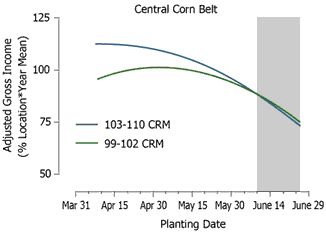
Figure 3. Adjusted gross income response to planting date for 103-110 CRM (mid-maturity) and 99-102 CRM (early maturity) hybrids in 30 central Corn Belt environments during 1987-2004.
North-Central Corn Belt
The north-central Corn Belt studies included 29 environments in South Dakota, Minnesota, Iowa, Michigan, and Ontario. Full-season hybrids planted in late April provided the greatest returns in this region (Figure 4).
Long-term data show that full season hybrids provide the greatest profitability until approximately May 28 in the north-central Corn Belt. Growers may consider switching to an early maturity hybrid after this point, especially if planting is delayed until June 1 or later when the economic advantage is more significant.
Growers in the north-central Corn Belt planting mid-maturity hybrids should consider switching to an early maturity hybrid only if planting is delayed until after June 5 (Figure 5). After June 11, the data indicate a significant advantage to switching.
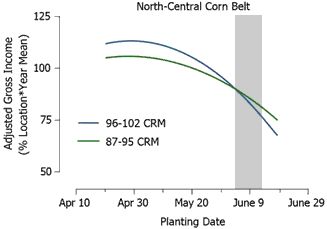
Figure 5. Adjusted gross income response to planting date for 96-102 CRM (mid-maturity) and 87-95 CRM (early maturity) hybrids in 29 north-central Corn Belt environments during 1987-2004.
Northen Corn Belt
The northern Corn Belt studies included 17 environments in Minnesota and Wisconsin. The optimum planting timing in this region was late April or early May (Figure 6).
Growers may consider switching from a full season to an early hybrid when planting is delayed past May 27. If planting is delayed until June 7 or later, an early maturity hybrid will most likely be more profitable than a full season hybrid.
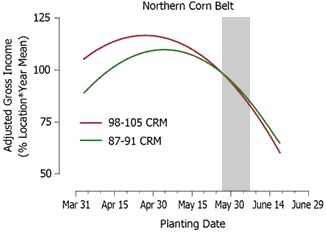
Figure 6. Adjusted gross income response to planting date for 98-105 CRM (full season) and 87-91 CRM (early maturity) hybrids in 17 northern Corn Belt environments during 1987-2004.
Adjusted gross income of mid-maturity hybrids was greater than that of early maturity hybrids throughout the planting date range of the northern Corn Belt studies, indicating no advantage to hybrid switching, even with extremely delayed planting (Figure 7).

Figure 7. Adjusted gross income response to planting date for 92-97 CRM (mid-maturity) and 87-91 CRM (early maturity) hybrids in 17 northern Corn Belt environments during 1987-2004.
Far Northen Corn Belt
The far northern Corn Belt studies included 15 environments in North Dakota, Minnesota, and Quebec. Early May planting of full season hybrids provided the greatest long-term profitability in this region (Figure 8).
Long-term data show that full season hybrids provide the greatest profitability until at least May 26 in the far northern Corn Belt. If planting is delayed until June 3 or later, an early maturity hybrid will be more profitable than a full season hybrid in most cases.
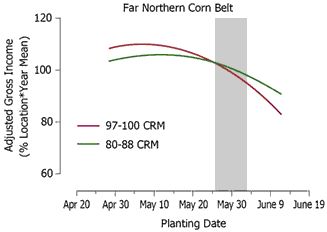
Figure 8. Adjusted gross income response to planting date for 97-100 CRM (full-season) and 80-88 CRM (early maturity) hybrids in 15 far northern Corn Belt environments during 1987-2004.
Growers in the far northern Corn Belt planting mid-maturity hybrids should not consider switching to an early maturity hybrid unless planting is delayed until after May 27 (Figure 9). Growers may consider switching after this point; however, long-term data did not show a significant advantage to doing so.
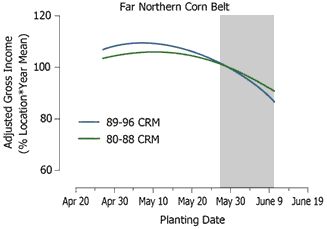
Figure 9. Adjusted gross income response to planting date for 89-96 CRM (mid-maturity) and 80-88 CRM (early maturity) hybrids in 15 far northern Corn Belt environments during 1987-2004.
Grain Moisture
Delayed planting can influence corn grain moisture at harvest, which affects overall profitability. However, the importance of grain moisture must be considered within the context of yield potential and harvest schedule. Early maturity hybrids may allow for earlier harvest timing, but may also have a lower yield potential than full-season hybrids.
By comparing harvest moisture (CRM) ratings, you can estimate the difference in moisture content between hybrids and help plan a harvest schedule. A hybrid with a CRM difference of 10 would be approximately 10 days later to reach a similar harvest moisture level (normally in the low 20's) if planted on the same date as the earlier hybrid.
By using the general rule of thumb that one CRM equals ½ (.50) point of moisture, a hybrid that is rated 10 CRM later would be approximately 5 points wetter if both hybrids were planted and harvested on the same days. In the field, however, this relationship can change depending on harvest timing, moisture content at harvest and environmental conditions.
Corn Adjusts to Later Planting
A three-year study that was conducted by researchers at Purdue and Ohio State Universities documented that hybrids can adjust their growth and development, requiring fewer growing degree units (GDUs) to reach maturity when planted late (Table 1). Three hybrids were grown at two locations. GDUs to physiological maturity were measured. Early planting dates ranged from late April to early May, while late planting dates were from early to mid-June.
Table 1. Reduction in GDUs required to reach 50% black layer with delayed planting in a three-year study.
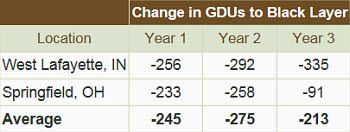
Averaged over all hybrids, locations and years, 244 less GDUs were required when planting was delayed from late-April or early May to early or mid-June (approximately 40 days). This is an average reduction in hybrid GDU requirement of about six GDUs per day of planting delay.
Agronomic Tips for Wet Spring Weather
- Working soils wet often results in season-long problems. Surface and subsoil compaction can reduce yields for years, especially on heavy soils. Cloddy seedbeds can result in poor germination and "leafing out" underground. Wait until fields dry for tillage, or switch to no-till planting.
- To expedite planting when fields dry, minimize tillage operations and trips across the field. No-tilling corn into soybean stubble is possible with most planters. Consider planting first, and applying nitrogen and herbicides later.
- Double disk openers slicing through wet soil can cause sidewall compaction in the seed furrow. This can hinder normal root development, especially if soils become dry and hard. It is usually best to wait until soils are drier.
- Seed furrow closure can be a problem when planting fields that are too wet. If subsequent dry conditions develop, the seed furrow can open as soils shrink. Check seed furrow closure carefully, especially in wet areas.
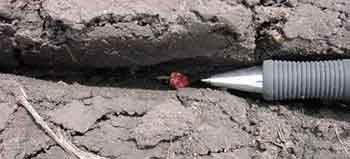

Sidewall compaction from planting in wet soil can hinder normal root development
